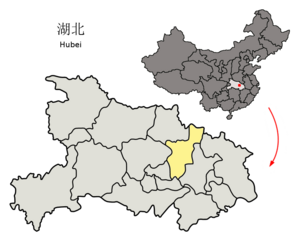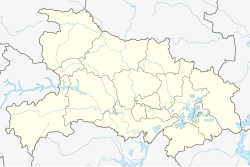Xiaogan
Xiaogan
孝感市 Siaokan | |
|---|---|
 view west towards city's south central area | |
 Location of Xiaogan City in Hubei and the PRC | |
| Coordinates (Xiaogan municipal government): 30°55′05″N 113°57′25″E / 30.918°N 113.957°E | |
| Country | People's Republic of China |
| Province | Hubei |
| Municipal seat | Xiaonan District |
| Area | |
| 8,922.72 km2 (3,445.08 sq mi) | |
| • Urban | 1,034.8 km2 (399.5 sq mi) |
| • Metro | 1,034.8 km2 (399.5 sq mi) |
| Population (2020 census)[1] | |
| 4,270,371 | |
| • Density | 480/km2 (1,200/sq mi) |
| • Urban | 988,479 |
| • Urban density | 960/km2 (2,500/sq mi) |
| • Metro | 988,479 |
| • Metro density | 960/km2 (2,500/sq mi) |
| GDP[2] | |
| • Prefecture-level city | CN¥ 145.7 billion US$ 23.4 billion |
| • Per capita | CN¥ 29,924 US$ 4,804 |
| Time zone | UTC+8 (China Standard) |
| Postal code | 432100 |
| Area code | 712 |
| ISO 3166 code | CN-HB-09 |
| Website | www |
Xiaogan (Chinese: 孝感; pinyin: Xiàogǎn) is a prefecture-level city in east-central Hubei province, People's Republic of China, some 60 kilometres (37 mi) northwest of the provincial capital of Wuhan. According to the 2020 census, its population totaled 4,270,371, of whom 988,479 lived in the built-up (or metro) area of Xiaonan District.
The city name Xiaogan, meaning Filial Piety Moves Tian (Chinese: 孝行感天), is from the story of Dong Yong, who sold himself for his father's funeral, in The Twenty-four Filial Exemplars.[3]
The Sheshui River originates in Xiaogan's Dawu County. On the third day of the third month of the lunar calendar, many in Wuhan eat 'di cai zhu ji dan' (地菜煮鸡蛋) which is supposed to prevent illness in the coming year. This practice is related to a story involving Shennong in Xiaogan.[4]
Administrative divisions
[edit]
Since 2000, Xiaogan has been divided into 1 district, 3 county-level cities and 3 counties:[5][6]
- Xiaonan District (孝南区)
- Yingcheng City (应城市)
- Anlu City (安陆市)
- Hanchuan City (汉川市)
- Xiaochang County (孝昌县)
- Dawu County (大悟县)
- Yunmeng County (云梦县)
| Map |
|---|
Climate
[edit]| Climate data for Xiaogan (1991–2020 normals, extremes 1981–2010) | |||||||||||||
|---|---|---|---|---|---|---|---|---|---|---|---|---|---|
| Month | Jan | Feb | Mar | Apr | May | Jun | Jul | Aug | Sep | Oct | Nov | Dec | Year |
| Record high °C (°F) | 20.6 (69.1) |
27.5 (81.5) |
31.4 (88.5) |
33.8 (92.8) |
35.3 (95.5) |
37.5 (99.5) |
39.4 (102.9) |
38.5 (101.3) |
38.4 (101.1) |
34.0 (93.2) |
28.8 (83.8) |
21.9 (71.4) |
39.4 (102.9) |
| Mean daily maximum °C (°F) | 8.1 (46.6) |
11.1 (52.0) |
16.0 (60.8) |
22.3 (72.1) |
27.0 (80.6) |
29.9 (85.8) |
32.5 (90.5) |
32.4 (90.3) |
28.7 (83.7) |
23.2 (73.8) |
16.9 (62.4) |
10.6 (51.1) |
21.6 (70.8) |
| Daily mean °C (°F) | 3.7 (38.7) |
6.5 (43.7) |
11.2 (52.2) |
17.2 (63.0) |
22.2 (72.0) |
25.8 (78.4) |
28.5 (83.3) |
27.9 (82.2) |
23.6 (74.5) |
17.7 (63.9) |
11.4 (52.5) |
5.7 (42.3) |
16.8 (62.2) |
| Mean daily minimum °C (°F) | 0.5 (32.9) |
2.9 (37.2) |
7.3 (45.1) |
13.0 (55.4) |
18.2 (64.8) |
22.5 (72.5) |
25.4 (77.7) |
24.7 (76.5) |
19.9 (67.8) |
13.8 (56.8) |
7.5 (45.5) |
2.1 (35.8) |
13.2 (55.7) |
| Record low °C (°F) | −13.7 (7.3) |
−7.3 (18.9) |
−2.7 (27.1) |
0.8 (33.4) |
8.3 (46.9) |
12.9 (55.2) |
18.6 (65.5) |
15.9 (60.6) |
10.7 (51.3) |
1.5 (34.7) |
−3.8 (25.2) |
−14.9 (5.2) |
−14.9 (5.2) |
| Average precipitation mm (inches) | 42.3 (1.67) |
52.3 (2.06) |
78.5 (3.09) |
117.0 (4.61) |
144.3 (5.68) |
183.0 (7.20) |
209.3 (8.24) |
113.3 (4.46) |
68.3 (2.69) |
61.0 (2.40) |
47.4 (1.87) |
25.6 (1.01) |
1,142.3 (44.98) |
| Average precipitation days (≥ 0.1 mm) | 8.5 | 9.7 | 11.3 | 10.6 | 12.1 | 11.2 | 10.8 | 9.1 | 7.2 | 8.9 | 8.3 | 6.6 | 114.3 |
| Average snowy days | 3.9 | 2.3 | 0.9 | 0 | 0 | 0 | 0 | 0 | 0 | 0 | 0.3 | 1.1 | 8.5 |
| Average relative humidity (%) | 76 | 76 | 76 | 76 | 77 | 82 | 82 | 80 | 77 | 77 | 77 | 74 | 78 |
| Mean monthly sunshine hours | 109.0 | 105.8 | 134.3 | 156.5 | 166.3 | 153.7 | 203.8 | 211.6 | 167.1 | 153.2 | 137.4 | 127.2 | 1,825.9 |
| Percent possible sunshine | 34 | 33 | 36 | 40 | 39 | 36 | 47 | 52 | 46 | 44 | 44 | 41 | 41 |
| Source: China Meteorological Administration[7][8] | |||||||||||||
Food
[edit]- Xiaogan Rice wine (孝感米酒)
Notable people from Xiaogan
[edit]Sister cities
[edit]References
[edit]- ^ "China: Húbĕi (Prefectures, Cities, Districts and Counties) - Population Statistics, Charts and Map". citypopulation.de. Retrieved 26 November 2021.
- ^ 湖北省统计局、国家统计局湖北调查总队 (August 2016). 《湖北统计年鉴-2016》. 中国统计出版社. ISBN 978-7-5037-7847-6. Archived from the original on 2017-03-01. Retrieved 2017-06-05.
- ^ 孝行感天-孝感的由来. Huaxia.com (in Simplified Chinese). 17 September 2009. Retrieved 27 March 2018.
孝感既为董永故里,其遗址很多,集中分布于两地:今孝感市区和董永曾长期生活过的今孝南区毛陈镇。
- ^ 三月三吃地菜煮鸡蛋能治头痛?专家:可防流感. 长江日报. 2018-04-19. Retrieved 1 May 2020 – via QQ News.
- ^ 2016年统计用区划代码和城乡划分代码:孝感市 (in Chinese). National Bureau of Statistics of the People's Republic of China. 2016. Retrieved 26 March 2018.
统计用区划代码 名称 420901000000 市辖区 420902000000 孝南区 420921000000 孝昌县 420922000000 大悟县 420923000000 云梦县 420981000000 应城市 420982000000 安陆市 420984000000 汉川市
- ^ 孝感市历史沿革 (in Chinese). XZQH.org. 7 December 2011. Retrieved 26 March 2018.
2000年第五次全国人口普查,孝感市总人口4992537人。其中:孝南区883123人,孝昌县612166人,大悟县605786人,云梦县571591人,应城市650485人,安陆市611990人,汉川市1057396人。
- ^ 中国气象数据网 – WeatherBk Data (in Simplified Chinese). China Meteorological Administration. Retrieved 23 September 2023.
- ^ "Experience Template" 中国气象数据网 (in Simplified Chinese). China Meteorological Administration. Retrieved 23 September 2023.
Further reading
[edit]- Acerbi, Jacob (2020). Chaos and Grime: A Year in the Life of a Chinese City. Philadelphia: LSI Holdings, LLC. ISBN 1734454415, 978-1734454413.
External links
[edit]![]() Media related to Xiaogan at Wikimedia Commons
Media related to Xiaogan at Wikimedia Commons


